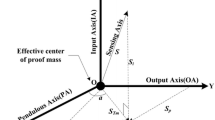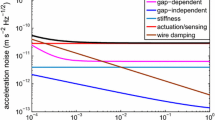Abstract
For appropriate application of an accelerometer, it is required to test the accurate magnitude and direction of its transverse sensitivity. The current testing methods usually adopt circular and linear orbits as acceleration inputs, both of which require accurate relative phases and amplitudes of the acceleration components. The elliptical orbit however is much easier to obtain. The method of determining the transverse sensitivity by an ellipse in proportion with the motion orbit and a straight line passing through the origin is investigated. The results of the elliptical orbit method match well with the current circular orbit method and have a good consistency at different shapes and orientations of elliptical orbits.













Similar content being viewed by others
References
ISO 16063-31, Methods for the calibration of vibration and shock transducers—Part 31: Testing of transverse vibration sensitivity (2009).
T. Petzsche, Determination of the transverse sensitivity using a mechanical vibration generator with turntable. ISO TC 108/SC 3/WG 6 Doc. N153 (2007).
C.S. Veldman, Implementation of an accelerometer transverse sensitivity measurement system, Test and measurement conference (2012).
J.J. Dosch, D.M. Lally, Automated testing of accelerometer transverse sensitivity, http://www.modalshop.com/techlibrary/JDosch%20transverse%20calibration.pdf (2000).
R.D. Sill, E.J. Seller, Accelerometer transverse sensitivity measurement using planar orbital motion, Proceedings of the 77th shock and vibration symposium, Monterey, CA, USA (2006) pp. 8–12.
W. Guan, X.F. Meng, X.M. Dong, Accelerometer transverse sensitivity testing with double turntable centrifuge, The I2MTC 2014 conference, Montevideo, Uruguay (2014), pp. 578–582.
W. Guan, X.F. Meng, X.M. Dong, Testing transverse sensitivity of linear single-axis pendulous accelerometer with double turntable centrifuge, MAPAN-J. Metrol. Soc India, 31 (2016) 69–74.
IEEE 836-2009, IEEE recommended practice for precision centrifuge testing of linear accelerometers (2009).
T. Usuda, H.J. Martens, C. Weißenborn, Theoretical and experimental investigation of transverse sensitivity of accelerometers under multiaxial excitation, Meas. Sci. Technol., 15 (2004) 896–904.
A. Umeda, M. Onoe, K. Sakata, et al., Calibration of three-axis accelerometers using a three-dimensional vibration generator and three laser interferometers, Sensors and Actuators A, 114 (2004) 93–101.
IEC 60747-14-4, Semiconductor devices—Discrete devices—Part 14-4: Semiconductor accelerometers (2011).
ISO 16063-1, Methods for the calibration of vibration and shock transducers—Part 1: Basic concepts (1998).
S. Gilbert, Introduction to linear algebra, Cambridge Press, Wellesley, (1994) pp. 330–335.
IEEE STD-1057, IEEE Standard for digitizing waveform recorders (1994).
Acknowledgements
This research is sponsored by National Natural Science Foundation of China (No. 51605461) and Quality Inspection Public Welfare Industry Research Project (No. 201410009).
Author information
Authors and Affiliations
Corresponding author
Rights and permissions
About this article
Cite this article
Liu, Z., Cai, C., Yu, M. et al. Testing of Accelerometer Transverse Sensitivity Using Elliptical Orbits. MAPAN 33, 217–226 (2018). https://doi.org/10.1007/s12647-018-0255-7
Received:
Accepted:
Published:
Issue Date:
DOI: https://doi.org/10.1007/s12647-018-0255-7




